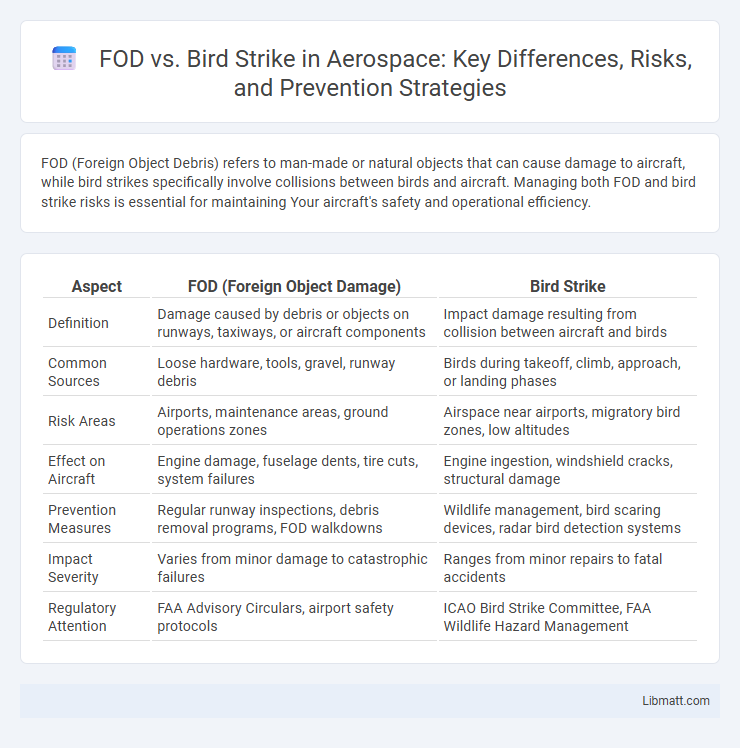FOD (Foreign Object Debris) refers to man-made or natural objects that can cause damage to aircraft, while bird strikes specifically involve collisions between birds and aircraft. Managing both FOD and bird strike risks is essential for maintaining Your aircraft's safety and operational efficiency.
Table of Comparison
| Aspect | FOD (Foreign Object Damage) | Bird Strike |
|---|---|---|
| Definition | Damage caused by debris or objects on runways, taxiways, or aircraft components | Impact damage resulting from collision between aircraft and birds |
| Common Sources | Loose hardware, tools, gravel, runway debris | Birds during takeoff, climb, approach, or landing phases |
| Risk Areas | Airports, maintenance areas, ground operations zones | Airspace near airports, migratory bird zones, low altitudes |
| Effect on Aircraft | Engine damage, fuselage dents, tire cuts, system failures | Engine ingestion, windshield cracks, structural damage |
| Prevention Measures | Regular runway inspections, debris removal programs, FOD walkdowns | Wildlife management, bird scaring devices, radar bird detection systems |
| Impact Severity | Varies from minor damage to catastrophic failures | Ranges from minor repairs to fatal accidents |
| Regulatory Attention | FAA Advisory Circulars, airport safety protocols | ICAO Bird Strike Committee, FAA Wildlife Hazard Management |
Understanding FOD and Bird Strikes
Foreign Object Debris (FOD) consists of loose objects on airport runways or aircraft surfaces that can cause significant damage to engines and airframes during takeoff or landing. Bird strikes occur when birds collide with aircraft, often damaging engines, windshields, or wings, posing serious safety risks. Understanding the causes and risks of both FOD and bird strikes helps you implement effective prevention strategies to enhance aviation safety.
Key Differences Between FOD and Bird Strikes
Foreign Object Debris (FOD) refers to any non-native objects such as loose hardware, stones, or tools that can cause damage to aircraft, whereas bird strikes specifically involve collisions with live birds during flight operations. FOD damage typically results from ground hazards affecting engines, tires, or fuselage, while bird strikes predominantly impact engines, windshields, and leading edges during takeoff or landing phases. Understanding these differences is critical for implementing targeted prevention measures, such as FOD control programs and wildlife management strategies at airports.
Common Sources of FOD on Runways
Common sources of Foreign Object Debris (FOD) on runways include loose hardware, tire fragments, gravel, and wildlife remnants, all of which pose significant threats to aircraft safety. Wildlife, especially birds, contribute to both FOD and bird strike incidents, with bird strikes frequently causing engine damage and structural impact on aircraft. Airports must implement rigorous FOD detection systems and wildlife management programs to mitigate risks associated with runway debris and bird activity.
Typical Causes of Bird Strikes
Bird strikes typically occur when birds collide with aircraft during takeoff, landing, or low-altitude flight, often due to bird migration paths near airports and feeding grounds. Factors such as poor visibility, weather conditions, and the presence of large flocks increase the likelihood of bird strikes. Airport environments attract birds because of open spaces, nearby water bodies, and food sources, making these areas high-risk zones for bird-related collisions.
Impact on Aircraft Safety
Foreign Object Debris (FOD) and bird strikes both pose significant threats to aircraft safety by causing engine failure, structural damage, and compromised flight performance. Bird strikes often result in rapid engine ingestion and windshield damage, leading to critical in-flight emergencies, while FOD, including loose hardware or wildlife on runways, can induce landing gear collapse and control surface malfunctions. Effective FOD management and wildlife hazard control are essential to minimize risk and maintain optimal operational safety standards.
Detection and Prevention Technologies
FOD (Foreign Object Debris) and bird strike detection and prevention technologies utilize advanced radar systems, infrared sensors, and AI-powered imaging to identify threats in real-time near airports and aircraft. Automated runway inspection vehicles equipped with LIDAR and high-resolution cameras rapidly detect debris, while avian radar systems predict bird movement patterns to mitigate collision risks. Integration of these technologies with airport wildlife management and aircraft sensor networks enhances proactive responses, reducing damage and ensuring aviation safety.
Economic Consequences of FOD and Bird Strikes
Foreign Object Debris (FOD) and bird strikes result in substantial economic consequences for the aviation industry, including costly aircraft repairs, increased maintenance, and extended downtime. The Federal Aviation Administration estimates that FOD-related damages exceed $4 billion annually worldwide, while bird strikes contribute to over $1 billion in expenses each year due to damage and flight disruptions. These incidents also lead to increased insurance premiums and heightened operational costs, affecting airline profitability and airport safety budgets globally.
Regulatory Standards and Guidelines
Regulatory standards and guidelines for FOD (Foreign Object Debris) and bird strikes are established by aviation authorities such as the FAA and ICAO to ensure aircraft safety and operational integrity. These regulations mandate systematic inspections, wildlife hazard management programs, and reporting protocols to mitigate risks associated with FOD and bird strikes. Your compliance with these standards enhances safety and reduces costly damage and operational disruptions.
Best Practices for Airport Management
Effective airport management implements comprehensive Foreign Object Debris (FOD) control programs and wildlife hazard management plans to mitigate FOD and bird strike risks, respectively. Routine runway inspections combined with the use of advanced radar and avian detection systems enhance early identification and removal of debris or hazardous wildlife. Training personnel in rapid response procedures and investing in habitat modification techniques near airfields further reduce incidents, ensuring safer operational environments.
Future Trends in Aviation Hazard Mitigation
Future trends in aviation hazard mitigation emphasize advanced sensor technologies and AI-driven detection systems to prevent FOD (Foreign Object Debris) and bird strikes. Integration of real-time data analytics and drone surveillance enhances early identification of potential threats on runways and surrounding airspace. Collaborative efforts between airports and wildlife management are expanding to develop eco-friendly deterrents and predictive modeling, reducing risks and improving aviation safety outcomes.
FOD vs Bird strike Infographic

 libmatt.com
libmatt.com